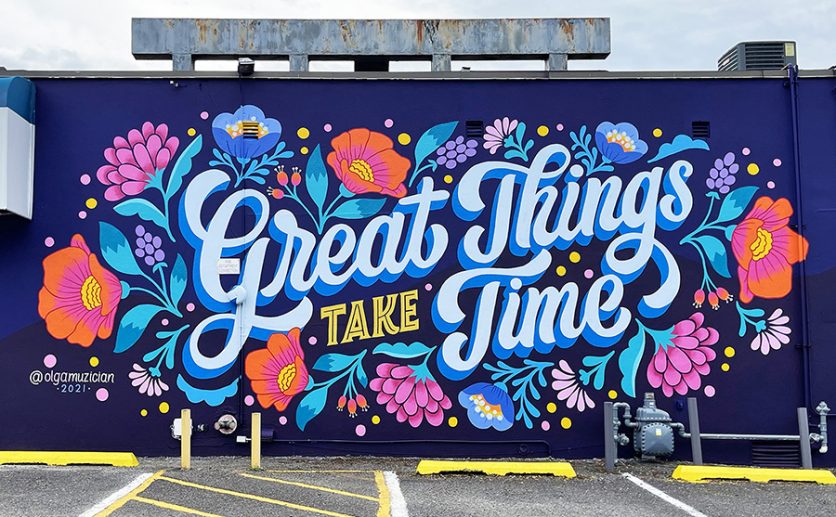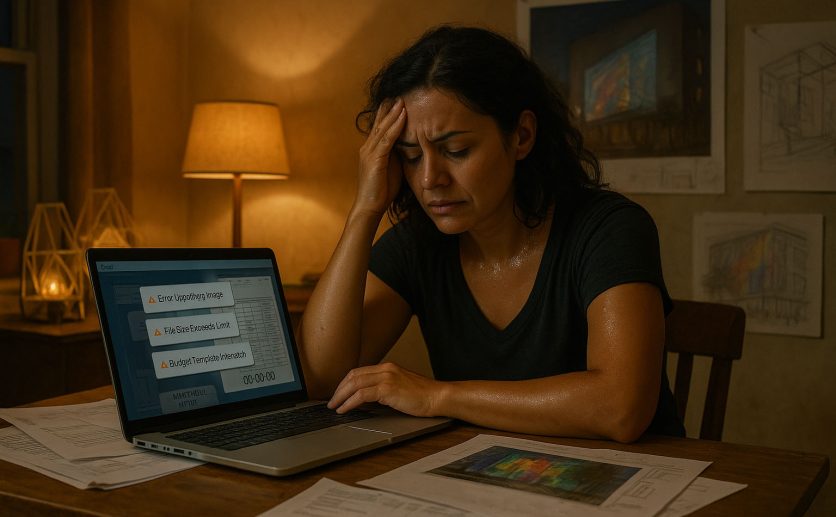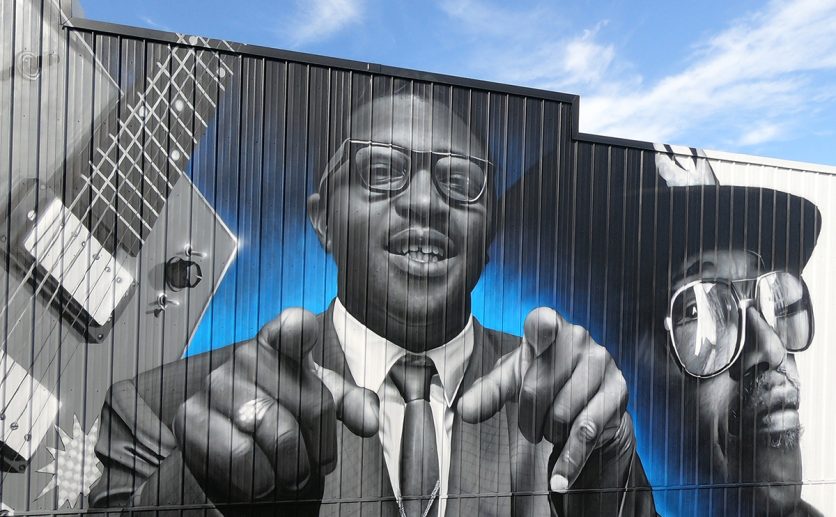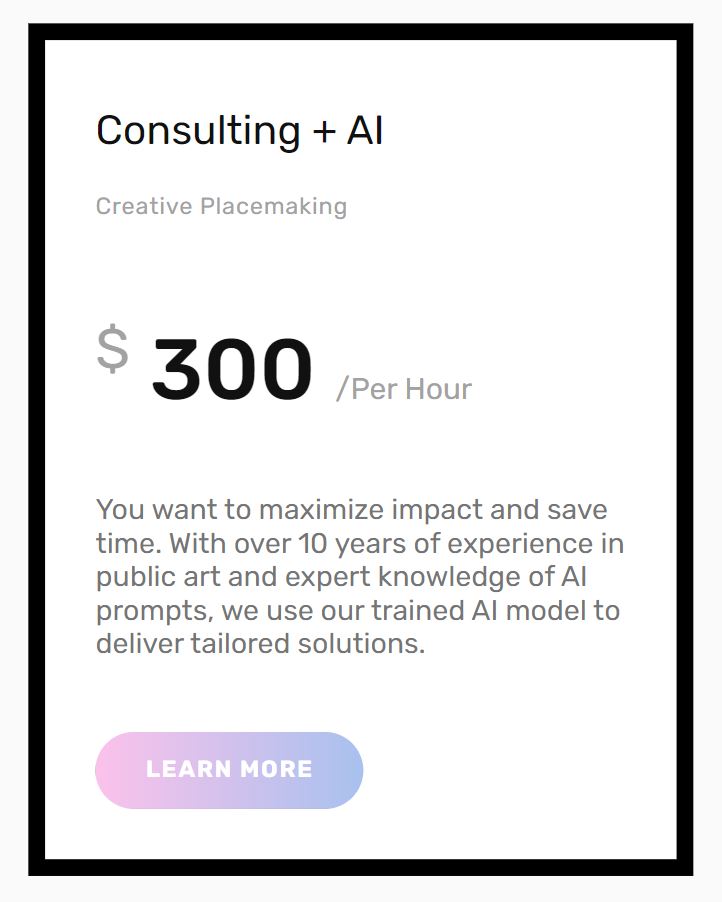Proposed Guidelines for Public Art Projects: Enhancing Engagement, Inclusivity, and Responsible AI Use
Public art plays a vital role in creating vibrant and inclusive communities. It enhances public spaces, fosters cultural expression, and encourages community engagement. To ensure the success of public art projects, it is crucial to follow best practices that promote accessibility, diversity, and transparency.
This article outlines key guidelines for creating impactful public art installations based on
resources from Americans for the Arts (AFTA), and has been elaborated by Monochronicle to provide comprehensive recommendations for public art projects. These guidelines aim to foster transparency, diversity, and inclusivity in the field, serving as a valuable resource for administrators, artists, and public art professionals. By incorporating these practices, projects can strive for excellence and meaningful community engagement.
On the cover: mural by Olga Muzician, Monochronicle Network.
Artist Selection Process
- Administrators should clearly communicate the project’s scope, medium (mural, sculpture, etc.), schedule, eligibility, and budget in Calls for Artists and all related communications, enabling artists to make informed decisions.
- Artists should follow the process and provide all requested information and an accurate portrayal of their roles and past work when presenting portfolios, ensuring transparency and integrity.
- Artists should design within the available budgets and propose realistic ideas that align with the project’s financial constraints, particularly during design competitions. This encourages feasibility and avoids resource gaps.
- Administrators and consultants should refrain from requesting artists to appropriate or use designs proposed by other artists in competitions. Likewise, artists should not exploit ideas or concepts presented by fellow competitors. Respecting intellectual property promotes fairness and ethical practices.
- Organizations commissioning artwork should compensate artists for their design proposals, acknowledging their contributions and efforts.
- Administrators should establish a fair and transparent process for project development and artist selection, ensuring equal opportunities for all artists.
- When developing projects and selecting artists, commissioning bodies should align their processes with the principles of cultural equity, as outlined in the Americans for the Arts Statement on Cultural Equity. This promotes inclusivity and diversity in public art projects.
- Administrators should safeguard artists’ private information in accordance with privacy policies and legal requirements.
- Involving arts professionals in the artist selection process brings expert perspectives and facilitates informed decision-making.
- Administrators and consultants should not accept monetary or other forms of compensation from artists being considered or awarded a project, maintaining the integrity of the selection process.
- To prevent conflicts of interest, all parties involved should disclose any potential conflicts, and decision-makers with conflicts should abstain from participating in the selection process.
Open Call for Artists
- Announce an open call for artists, inviting submissions from a wide range of individuals. This helps create a diverse pool of applicants and ensures equal opportunities for all artists.
- Selection committee: Establish a selection committee comprising diverse stakeholders, including community members, artists, arts professionals, and representatives from relevant organizations. This committee should have a fair and transparent selection process.
- Transparent criteria: Clearly communicate the selection criteria to all applicants and ensure they align with the project’s goals and objectives. The criteria may include artistic quality, experience, community engagement skills, feasibility, and alignment with the project’s theme.
- Anonymous review: Consider implementing an anonymous (blind) review process where the selection committee evaluates proposals without knowledge of the artists’ identities. This helps reduce biases and focuses solely on the artistic merit of the proposals.
- Evaluation rubric: Develop an evaluation rubric to guide decision-making. The rubric should assess criteria such as artistic excellence, innovation, community engagement potential, feasibility, and maintenance considerations.
- Panel discussion: Organize a panel discussion or interview with shortlisted artists to understand artistic vision, community engagement approach, and ability to execute successfully.
- Collaboration opportunities: Encourage artists to collaborate with community members, local organizations, or other artists to enhance community involvement and create culturally relevant artworks.
Agreements and Project Execution
- Contract and agreements: Once an artist is selected, ensure responsibilities, compensation, timeline, IP/copyright, licenses, credits, installation logistics, and maintenance are clearly outlined in a written contract or agreement.
- All projects should have written agreements that define scope of work, budget, and schedule. Sample documents provided by Americans for the Arts can serve as valuable resources.
- Provide sufficient time for all parties to review and understand agreements before signing; encourage artists to seek legal or business counsel when necessary.
- Establish a clear process for approving project changes, ensuring modifications are documented in writing to promote accountability and minimize misunderstandings.
- When significant redesign or proposal changes are requested and are not due to artist fault, artists should be fairly compensated.
- Mutually agree on the expected lifespan of the artwork and specify it in the agreement, facilitating proper planning for maintenance and conservation.
- Artists should select materials appropriate for the expected lifespan of their artwork and integrate components that align with minimum warranty periods required in the agreement. Consider how integrated components affect underlying warranties.
- Artist warranties should not exceed two years, maintaining a reasonable level of responsibility given the dynamic nature of public artwork in the built environment.
- Artists should pass along manufacturer warranties for integrated components, ensuring transparency and appropriate allocation of responsibility.
Insurance and Liability
- Administrators should collaborate with artists to assess the true cost of obtainable insurance, as required by law or municipal policies. Non-licensed artists may be exempt from professional liability and errors & omissions insurance, while licensed subcontractors may still be subject to these requirements.
- Avoid imposing unreasonable or inappropriate liability burdens on artists, ensuring fairness and proportionality.
- Artists should execute written agreements with their subcontractors, incorporating relevant requirements from the prime contract to maintain consistency and clear expectations.
Credit, Copyright, and Maintenance
- Project payment schedules should align with the cash flow needs of the artwork’s deliverables, providing artists with adequate support throughout the project timeline.
- Artists retain copyright to their artwork. Contracting agencies or ultimate owners may receive reasonable licenses for documentation, publicity, education, and promotion, subject to mutual agreement.
- Artists and commissioning bodies or owners should mutually credit and acknowledge each other’s roles, recognizing the collaborative nature of public art projects.
- Maintenance & Conservation: Establish clear maintenance plans and allocate resources for ongoing care, including periodic cleaning, repairs, and conservation treatments. Engage professional conservators and involve artists in long-term maintenance to ensure sustained quality and appearance.
- Detailed and feasible maintenance and conservation plans should be discussed and agreed upon by all parties involved.
- Commissioning bodies or ultimate owners should have established collection management policies and inform artists of these policies, promoting responsible stewardship.
- In the event of artwork damage, administrators should consult with artists in good faith regarding repairs, adhering to best conservation practices.
- In cases where Visual Artists Rights Act (VARA) rights are waived, agreements should still grant artists the right to remove their names from artworks if damage, alteration, or relocation occurs without the artist’s approval and if the artwork no longer represents their vision.
Community Engagement
- Prioritize meaningful community engagement throughout planning, design, and implementation. Involve local residents, community organizations, and stakeholders via public meetings, workshops, and open forums to gather input, ideas, and feedback.
- Artistic Diversity & Representation: Actively seek opportunities to collaborate with artists from diverse backgrounds, cultures, and perspectives. Prioritize underrepresented artists to foster a more inclusive public art landscape.
- Accessibility & Inclusivity: Consider physical and sensory accessibility (e.g., wheelchair-accessible paths, tactile elements, captioned/ASL video tours, multilingual materials) so all community members can experience the work.
- Documentation & Promotion: Document processes and outcomes through photography, video, and written materials. Share across social media, websites, and local media to raise awareness and broaden engagement.
- Public Input & Feedback: Encourage ongoing input through surveys, meetings, and online platforms. Regularly evaluate impact (public space usage, community pride, social cohesion, engagement).
- Public-Private Partnerships: Foster collaborations between public entities, private organizations, and philanthropic foundations to leverage resources, venues, and engagement support.
- Celebrate Diverse Cultures & Histories: Use public art as a platform to acknowledge and celebrate diverse cultures and histories within a community by incorporating stories, symbols, and traditions that strengthen belonging and understanding.
Site-Specificity, Sustainability, and Education
- Site-Specificity: Integrate artwork thoughtfully into the surrounding environment, considering unique characteristics, history, and culture. Use site visits, research, and dialogue to create installations that resonate locally and create a sense of place.
- Sustainability & Environmental Responsibility: Favor materials and techniques that minimize environmental impact (e.g., recycled/repurposed materials, energy-efficient lighting, eco-friendly maintenance practices).
- Education & Interpretation: Provide interpretative elements (signage, plaques, interactive components) explaining concept, process, and context. Partner with educational institutions to develop programs and workshops that deepen understanding.
- Temporary & Pop-Up Installations: Use temporary projects to experiment, activate underutilized spaces, and engage the public in new ways (exhibitions, street-art festivals, interactive installations).
Processes to Avoid Biases in Artist Selection
- Anonymous portfolio review: Implement an initial review where the selection committee assesses portfolios without personal information, ensuring evaluation based solely on artistic merit.
- Diverse selection committee: Ensure the committee represents a broad range of backgrounds (race, ethnicity, gender, age, disability, and artistic expertise) to mitigate bias and add perspectives.
- Implicit bias training: Provide training for committee members to raise awareness of unconscious biases and promote fair decision-making.
- Blind voting: Use anonymous voting methods to reduce influence of personal relationships or reputational bias.
- Community involvement: Include community representatives on the committee and, where appropriate, offer public input or advisory votes.
- Artist statements: Emphasize statements that focus on creative vision, process, and community relevance rather than demographic identity to keep focus on the work.
Responsible AI Use in Public Art (New)
As AI tools increasingly influence creative practice and administration, public art projects should adopt clear, responsible-use guidelines that protect artists and communities, reduce bias, and maintain transparency.
Organizational Expectations for AI Use
- Disclosure & Attribution: Require artists to disclose whether and how AI tools contributed to any phase (research, ideation, rendering, fabrication, interactivity). Credit significant tools and technical collaborators similar to fabricators or assistants.
- Human Authorship & Intent: Make explicit that AI should augment—not replace—the artist’s creative authorship. Proposals should describe human decision-making and artistic intent.
- Dataset Legality & Consent: Prohibit training or prompting on copyrighted, proprietary, or privacy-sensitive material without appropriate licenses or explicit permissions. Favor public-domain or properly licensed sources.
- Bias Review: Ask artists to briefly assess potential representational bias (e.g., stereotypes, exclusion) in AI outputs and describe steps taken to mitigate it (curation, prompt strategy, post-editing, community review).
- Community Review for AI-Mediated Works: For interactive or generative installations, include user-safety considerations (harassment filtering, accessibility) and a plan to moderate or curate outputs displayed to the public.
- Provenance & Watermarking (where feasible): Encourage embedding provenance or content credentials (e.g., C2PA-style metadata) or visible labels indicating AI involvement to support transparency for audiences.
- Accessibility & UX: Ensure AI-enabled experiences meet accessibility standards (captions, audio description, screen-reader compatibility, tactile alternatives where applicable).
- Maintenance & Versioning: For works dependent on models or APIs, include a maintenance plan addressing software updates, version changes, uptime expectations, and end-of-life behavior.
Data Privacy & Security
- Secure Storage: Store submissions (images, CVs, proposals, juror notes) in secure environments. Prefer region-appropriate hosting and documented access controls. Avoid sharing juror comments outside the authorized process.
- No Unrelated AI Training: Do not use artist submissions (images, text, videos) to train unrelated AI systems without explicit, opt-in consent. Respect the right to withdraw consent.
- Clear Terms: Provide plain-language terms covering retention periods, permitted uses, takedown processes, and the right to be forgotten where applicable.
What Organizations Should Ask Artists To Do
- Disclose AI use and provide a short statement on authorship and bias mitigation.
- Confirm legality/licensing of source materials and datasets used.
- Provide alt text/captions and inclusive interaction patterns for AI-enabled works.
- Outline maintenance, moderation, and fallback behavior if systems fail.
What Organizations Should Not Ask of Artists
- Do not require artists to surrender copyright over AI-assisted work; use limited, project-specific licenses instead.
- Do not compel use of specific proprietary AI tools that conflict with artist values, licensing constraints, or accessibility needs.
- Do not demand training data disclosure beyond reasonable compliance and licensing proof where it would expose trade secrets or personal data—seek attestations instead.
- Do not allow AI-only authorship without meaningful human creative control and accountability.
Conclusion
These proposed guidelines for public art projects, developed by Monochronicle and informed by resources from Americans for the Arts, provide a comprehensive framework to enhance engagement, inclusivity, and excellence in the field of public art. By adhering to these best practices—and by adopting responsible AI standards that protect artists, reduce bias, and foster transparency—communities can create engaging, inclusive, and meaningful spaces that reflect shared values and aspirations. Through thoughtful planning, community engagement, accessibility, and ethical technology use, public art can enrich lives and transform public spaces into vibrant cultural landscapes.





